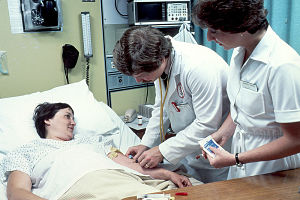Study: One-Quarter of Diagnostic Catheterizations for Suspected Coronary Artery Disease are Unnecessary
ALBANY, N.Y. (February 10, 2014) -- One-quarter of patients undergoing diagnostic catheterizations (DC) for suspected coronary artery disease in New York were rated as inappropriate for the procedure primarily because they were relatively healthy, a recent study finds.In the study published in January's Circulation: Cardiovascular Interventions, University at Albany School of Public Health and New York State Department of Health researcher Edward Hannan examined New York’s Cardiac Diagnostic Catheterization Database to identify patients undergoing DC for coronary artery disease between 2010 and 2011.
Patients were rated using appropriateness criteria developed by professional societies as appropriate, uncertain, and inappropriate for DC. The relationships between various patient characteristics and the appropriateness ratings were examined, along with the relationships between hospital-level inappropriateness for DC and other hospital-level variables (hospital DC volume and percutaneous coronary intervention inappropriateness).
 |
|
A quarter of all patients undergoing diagnostic catheterizations for coronary artery disease in New York were rated as inappropriate for the procedure because they were relatively healthy, a new study finds.
|
Of the 8,986 patients who were rated, 35.3 percent were rated as appropriate, 39.8 percent as uncertain, and 24.9 percent as inappropriate for DC. Of the 2,240 patients rated as inappropriate, 56.7 percent were asymptomatic, had no previous stress test, or had low or intermediate coronary artery disease risk. An even 36 percent had a previous stress test with low-risk findings and no symptoms, and 7.3 percent were symptomatic, had no previous stress test, or had low pretest probability.
Further, the study found that while one-quarter of patients undergoing DC for suspected coronary artery disease were rated as inappropriate for the procedure, approximately two-thirds of those inappropriate patients had no previous stress test, and approximately 90 percent of the inappropriate patients with no previous stress test were asymptomatic with low or intermediate global risk scores, i.e. the majority of those rated as inappropriate for DC procedures were comparatively healthy.
At the hospital level, the inappropriateness of DC procedures rate ranged from a maximum of 48.8 percent to a minimum of 8.6 percent. The researchers suggest that since a wide range of inappropriateness rates exists across hospitals, hospitals with very high rates could learn best practices DC protocols from hospitals with the lowest rates.
![]() For more news, subscribe to UAlbany's RSS headline feeds
For more news, subscribe to UAlbany's RSS headline feeds
A comprehensive public research university, the University at Albany-SUNY offers more than 120 undergraduate majors and minors and 125 master's, doctoral and graduate certificate programs. UAlbany is a leader among all New York State colleges and universities in such diverse fields as atmospheric and environmental sciences, business, education, public health,health sciences, criminal justice, emergency preparedness, engineering and applied sciences, informatics, public administration, social welfare and sociology, taught by an extensive roster of faculty experts. It also offers expanded academic and research opportunities for students through an affiliation with Albany Law School. With a curriculum enhanced by 600 study-abroad opportunities, UAlbany launches great careers.


